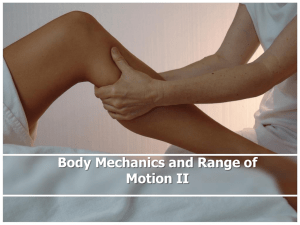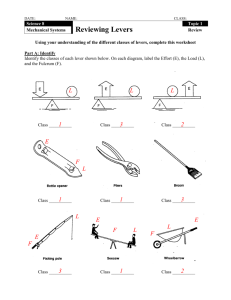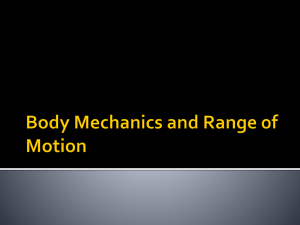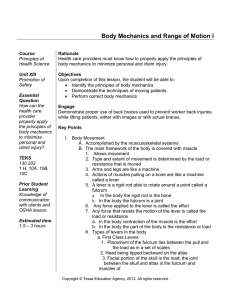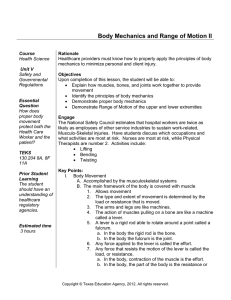Body Mechanics
advertisement
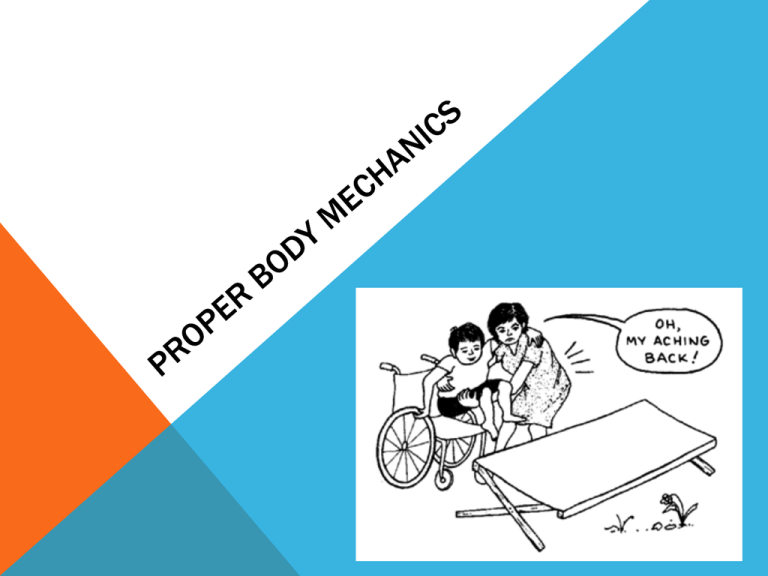
• Health care providers must know how to properly apply the principles of body mechanics to minimize personal and client injury • The number of injuries in health care facilities related to improper use of body mechanics has risen over the years WHY IS THIS IMPORTANT TO YOU? First Class Lever Head being tipped backward on the atlas The facial portion of the skull is the load, the joint between the skull and the atlas is the fulcrum, and muscles of the back produce the pull TYPES OF LEVERS IN THE BODY Second Class Lever Raising the body on the toes The point of contact between the toes and the ground is the fulcrum, the load is located at the ankle, and the pull is exerted at the gastrocnemius (the muscle in the calf) TYPES OF LEVERS IN THE BODY Third Class Lever Flexing of the forearm at the elbow joint as in lifting a hand weight The load is the weight in the hand, the pull is the biceps brachii muscle, and the fulcrum is the elbow. This is the most common lever in the body TYPES OF LEVERS IN THE BODY Use the larger and stronger muscles to perform work When moving heavy objects, push or pull instead of lifting Get help! Maintain good posture • Back straight • Knees bent • Weight evenly distributed on both feet • Feet shoulder width apart (about 12 inches) Avoid twisting your whole body Keep objects close to your body when listing or carrying Avoid unnecessary bending PRINCIPLES OF BODY MECHANICS You should use proper body mechanics at all times! In everyday activity such as carrying your schools books, getting in or out of your car, moving a chair In health care setting such as when moving a patient to or from a chair, picking up supplies, or positioning a patient in bed WHEN SHOULD YOU USE BODY MECHANICS? Ergonomics: the science of work Fit the work to the user instead of forcing the user to the work OSHA has developed a policy of “no lifting” in Long Term Care Facilities and other high risk areas http://www.osha.gov/SLTC/etools/nursinghome/index.html ERGONOMICS Find a partner Number 1-5 on a piece of notebook paper Go through the five activities on the Body Mechanics Activity worksheet one partner at a time and check off on your notebook paper once your partner does each activity correctly LET’S TRY IT OUT! Range of Motion: the complete extent of movement of which a joint is capable RANGE OF MOTION Active Range of Motion Movements performed by the patient without help RANGE OF MOTION Passive Range of Motion Movement cannot be performed by the patient and the health care worker moves each join through its range of motion RANGE OF MOTION Active Assistive Range of Motion The patient does the exercises with some assistance from another person RANGE OF MOTION

